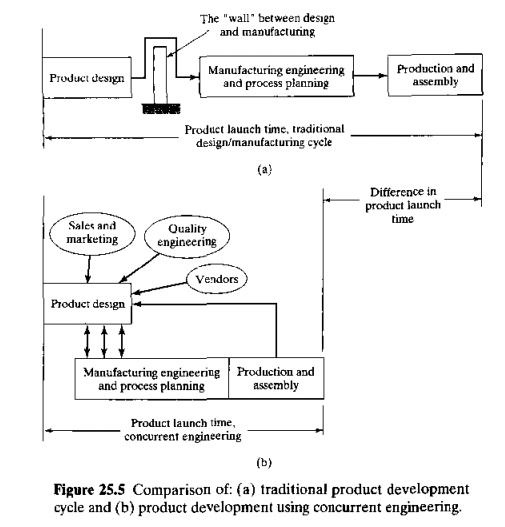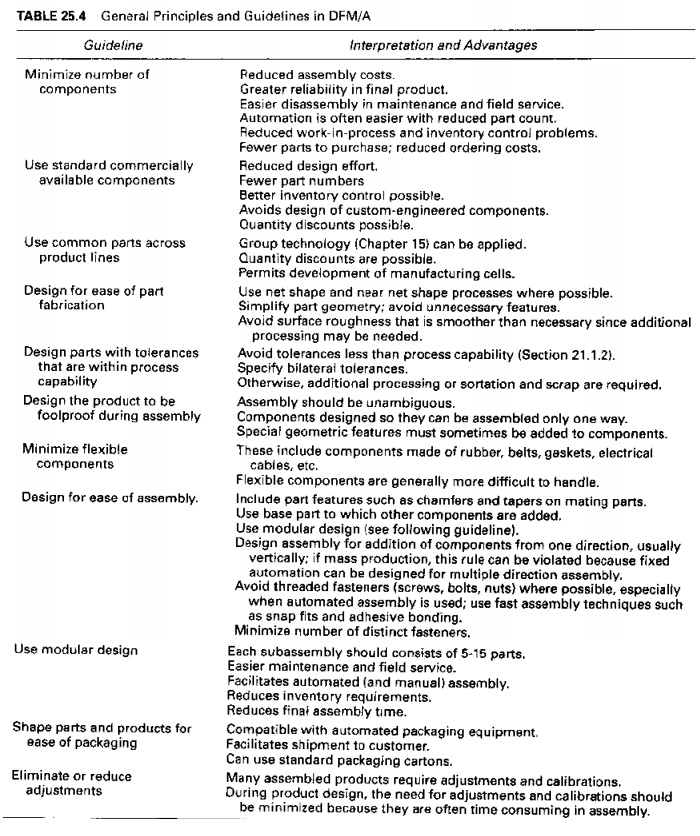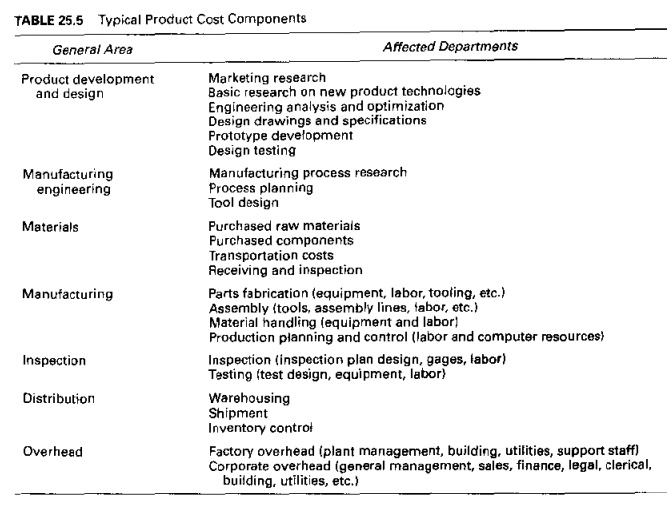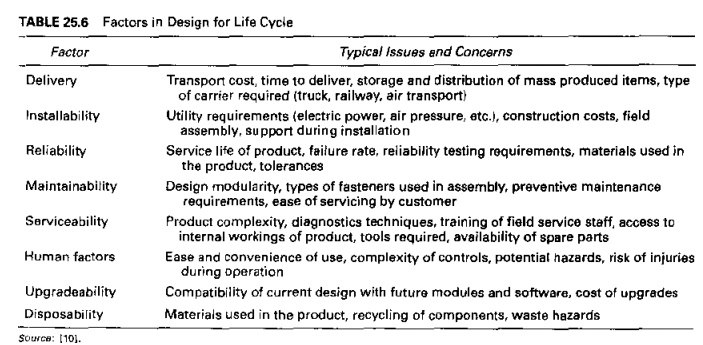Chapter: Automation, Production Systems, and Computer Integrated Manufacturing : Process Planning and Concurrent Engineering
Concurrent Engineering and Design for Manufacturing
CONCURRENT ENGINEERING AND DESIGN FOR MANUFACTURING
Concurrent engineering refers to
an approach used in product development in which the functions of design engineering, manufacturing engineering, and
other functions are integrated to reduce the elapsed time required to bring a
new product to market. Also called simultaneous
engineering, it might be thought of as the organizational counterpart to CAD/CAM technology. In the traditional
approach 10 launching a new product, the two functions of design engineering
and manufacturing engineering tend to be separated and sequential. as
illustrated in Figure 25.5(a). The product design department develops the new
design, sometimes without much consideration given to the manufacturing
capabilities of the company. There is little opportunity for manufacturing
engineers to offer advice

Figure 15.5
Comparison of: (a) traditional product development cycle and (b) product development using concurrent engineering.
on how
the design might be altered to make it more manufacturable. It is as if a wall
exists between design and manufacturing. When the design engineering department
completes the design, it tosses the drawings and specifications over the wall,
and only then does process planning begin.
By
contrast, in a company that practices concurrent engineering, the manufacturing
engineering department becomes involved in the product development cycle early
on, providing advice on how the product and its components can be designed to
facilitate manufacture and assembly. It also proceeds with the early stages of
manufacturing planning for the product. This concurrent engineering approach is
pictured in Figure 2S.5(b). In addition 10 manufacturing engineering, other
functions are also involved in the product development cycle, such as quality
engineering, the manufacturing departments, field service, vendors supplying
critical components, and in some cases the customers who will use the product.
AU of these functions can make contributions during product development to
improve not only the new product's function and performance, but also its produce
ability. inspectability, testability, serviceability, and maintainability.
Through early involvement, as opposed to reviewing the final product design
after it is too late to conveniently make any changes in the design, the
duration of the product development cycle is substantially reduced.
Design for
Manufacturing and Assembly
It has
been estimated that about 70% of the life cycle cost of a product is determined
by basic decisions made during product design. These design decisions include
the material for each part. part geometry, tolerances, surface finish, how
parts are organized into subassemblies. and the assembly method, to he used. Once these decisions are
made, the ability to reduce the manufacturing cost of the product is limited. For example.
if the product designer decides that a part is to be made of an aluminum sand
casting but which possesses features that can he achieved only h) machining (such as threaded
holes and close tolerances). the manufacturing engineer has no alternative
except to plan a process sequence that starts WIth sand casting followed by the sequence of machining
operations needed to achieve the specified features. In this example, a better
decision might be to use a plastic molded part that can be made in a single
step. It is important for the manufacturing engineer to be given the
opportunity to advise the design engineer as the product design is evolving, to
favorably influence the manuacturability of the product.
Terms used
to describe such attempts to favorably influence the rnanufacturability of a
new product are design .for manufacturing
(DFM) and design for assembly (DFA).
Of course, DFM and DFA arc inextricably linked, so let us use the term design for manufacturing and assembly (DFMIA).
Design for manufacturing and assembly involves the systematic consideration of
rnanufacturability and assemblability in the development of a new product
design. This includes: (l)
organizational changes and (2) design principles and guideline,
Organizational Changes in DFMIA. Effective
implementation of DFMlA, involves making
changes in a company's organizational structure. either formally or informally,
so that closer interaction and better communication occurs between design and manufacturing
personnel. This can he accomplished in several ways: (1) by creating project
teams consisting of product designers, manufacturing engineers, and other
specialties (e.g., quality engineers, material scientists) to develop the new
product design; (2) by requiring design engineers to spend some career time in
manufacturing to witness firsthand how manufacturabihty and assemblability are
impacted by a product's design; and (3) by assigning manufacturing engineers to
the product design department on either a temporary or fulltime basis to serve
as producibility consultants.
Design Principles and Guidelines. DFM/A also relies on the use
01 design principles and guidelines for
how 10 design a given product to maximize manufacturability and
asscrnblability. Some of these arc universal design guidelines that can be applied
to nearly any product design situation, such as those presented in Table 25.4.
In other cases, there are design principles that apply to specific processes,
for example, the use of drafts or tapers in casted and molded parts to
facilitate removal of the part from the mold, We leave these more process-specific
guidelines to texts on manufacturing processes, such as .
The guideline.
sometimes conflict with one another. for example. one of the guidelines in
Table 25.4 is to "simplify part geometry; avoid unnecessary
features." But another guideline in the
same table states that "special geometric features must sometimes be added
to components" to design the product for foolproof assembly. And it may also be desirable to
combine features of several assembled parts into one component to minimize the
number of parts in the product. In these instances. design for part manufacture
is in conflict with design for assembly, and a suitable compromise must be
found between the opposing sides of the conflict.

Other
Product Design Objectives
To
complete our coverage of concurrent engineering, let us hriefly discuss the
other design objectives: design for quality, cost, and life cycle.
Design
for Quality. It might be argued that DFM/A is the most important component
of concurrent engineering because it has the potential for the greatest impact
on product cost and development time. However. the importance of quality in
international competition cannot be minimized. Quality does not just happen. It
must be planned for during product design and during production. Design for quality (DFQ) is the term
that refers to the principles and procedures employed to ensure that the
highest possible quality is designed into the product. The general objectives
of DFQ are [1]: (1) to design the product to meet or exceed customer
requirements; (2) to design the product to be "robust," in the sense
of Taguchi (Section 20.3.2), that is, to design the product so that its
function and performance are relatively insensitive to variations in
manufacturing and subsequent application; and (3) to continuously improve the
performance, functionality. reliability, safety. and other quality aspects of
the product to provide superior value to the customer.
Our
discussion of quality in Part IV (Chapters 2023) is certainly consistent with
the focus of design for quality, but our emphasis in those chapters was
directed more at the operational aspects of quality during production. Among
those chapters, the Taguchi quality engineering methods (Section 20.3) are
applicable ill design
for quality. Another approach that is gaining acceptance is quality function
deployment, discussed in Section 24.5.
Design
for Product Cost. The cost of a product is a major factor in
determining its commercial success, Cost affects the price charged for the product
and the profit made by the company producing
it. Design for product cost (DFC) refers to the efforts of a company to
specifically identify how design decisions affect product costs and to develop
ways to reduce cost through design. Although the objectives of DFC and DFMIA
overlap to some degree, since improved manufacturability usually results in
lower cost, the scope of design for product cost extends beyond only
manufacturing in its pursuit of cost savings, as indicated by the list of
typical product cost components in Table 25.5.
Design
for Life Cycle. To the customer, the price paid for the product may
be a
small
portion of its total cost when life cycle costs are considered. Design for life cycle refers to the product
after it has been manufactured and includes factors ranging from product
delivery to product disposal. Most of the significant life cycle factors are
listed in Table 25.6. Some customers (e.g., the federal government) include
consideration of these costs in their purchasing decisions. The producer of the
product is often obligated to offer service contracts that limit customer liability
for out-of-control maintenance and service costs. In these cases, accurate
estimates of these life cycle costs must be included in the total product cost
.


Related Topics